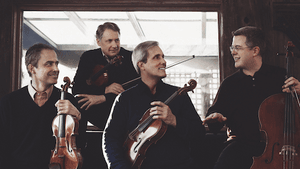Stay in the Loop
BSR publishes on a weekly schedule, with an email newsletter every Wednesday and Thursday morning. There’s no paywall, and subscribing is always free.
Still standing tall
Philadelphia Chamber Music Society presents the Emerson Quartet

The Emerson Quartet has been one of the world’s renowned chamber ensembles for nearly 40 years. From the start, its signature sound was a hard-driving performance style that refreshed classics, and gave a prominent hearing to newer works. Since 2002 it has also been distinctive for playing while standing in the style of rock musicians, with only the cellist seated as a concession to the instrument’s dimensions.
Emerson’s violinists, Eugene Drucker and Philip Setzer, and their violist, Lawrence Dutton, still play on their feet, and they are still exceptional musicians. But groups that challenge need challenge themselves, and the addition in 2013 of cellist Peter Watkins has given them a new focus. Watkins is of his colleagues’ generation, but his performance is strikingly different. Drucker, Setzer, and Dutton play poker faced, even if their art is deeply expressive. Watkins, whose chair on a riser is the group’s visual focus, makes music with a continual play of emotion on his features, and he’s become the focus of the Emerson’s renewed energies too.
Rarities meet history
The quartet’s recital in this year’s Chamber Music Society series offered no new works, but a couple of relative rarities. Beethoven’s Serioso Quartet, the Op. 95, which has always been an outlier in the cycle of his quartets, opened the program. His First and Second Rasumovsky Quartets, composed four years before, were revolutionary works that redefined not only their own genre but, with the Eroica Symphony and Kreutzer and Appassionata sonatas, the expressive potential and intellectual penetration of music. The Serioso — a title given to the Op. 95 by Beethoven — isn’t grandly ambitious in the way of these earlier works, but its compression of materials and concentration of form chalked a new road to the future. If it has a parallel among Beethoven’s other compositions, it’s with the Fifth Symphony, a work of similar tautness and unity of mood.
Emerson played the Beethoven more for refinement than force, but with conviction. A similar sense of mellowness pervaded its reading of Shostakovich’s Fourth Quartet. Shostakovich is the only great composer to have spent his career under a totalitarian regime, which meant, among other things, that political drama surrounded his major compositions. The Fourth Quartet is a case in point. Hoping that chamber music would be less likely to attract official attention, Shostakovich turned to the form in 1948-52 following the renewed and more sweeping attacks on musical “formalism” that singled him out in 1936. Nonetheless, the Fourth Quartet was consigned to the drawer, and performed publicly along with its immediate successor only after Stalin’s death.
The decision not to expose the Fourth Quartet was prudent. The new attack on formalism was part of a broader purge in the arts and sciences that specifically targeted Jewish artists and intellectuals. Shostakovich had numerous Jewish colleagues and students and a deep interest in Hebraic music that was evidenced in his Second Piano Trio as well as his Op. 79 song cycle, From Jewish Folk Poetry. The Fourth Quartet is suffused with the sounds and inflections of klezmer music, and Shostakovich’s personal identification with Jewish suffering is evident throughout. As such, it remains a courageous and deeply humane work, laid aside as a testimonial to be heard in a less dark time.
Return to the robust
The Emerson’s own violinists are Jewish, and its performance of the Fourth Quartet emphasized its klezmer tonalities in a restrained but deeply inward and penetrating way. This is music that can also be played more robustly, and at one time the Emerson might have opted for such an approach, but I appreciate the maturity of its present conception.
The older Emerson sound, full and bold, returned with the work that concluded the concert, Tchaikovsky’s Third Quartet. The relative neglect of this rich and ambitious score, which, with the Piano Trio in A Minor and the String Sextet, makes one of the triad of Tchaikovsky’s greatest chamber compositions, is hard to account for. It’s also a work that, with its two predecessors in the genre, is the foundation of the Russian string quartet tradition.
The Third Quartet stands beside anything in the literature that precedes it, brilliantly exploiting the possibilities of string writing and offering dark sonorities of almost symphonic texture and density. The most magical moment in Emerson’s performance, though, was in the rising, celestial chords with which the Andante funèbre concludes. Emerson is still making music at its best.
What, When, Where
The Emerson Quartet, presented by the Philadelphia Chamber Music Society. Beethoven, String Quartet No. 11 in F Minor, Op. 95; Shostakovich, String Quartet No. 4, Op. 83; Tchaikovsky, String Quartet No. 3 in E-flat Minor, Op. 30. December 9, 2016 at the Kimmel Center's Perelman Theater, 300 S. Broad Street, Philadelphia. (215) 569-8080 or pcmsconcerts.org.
Sign up for our newsletter
All of the week's new articles, all in one place. Sign up for the free weekly BSR newsletters, and don't miss a conversation.

 Robert Zaller
Robert Zaller